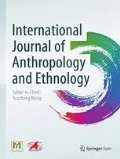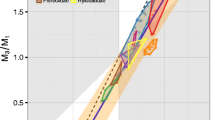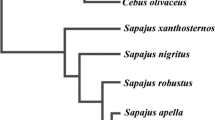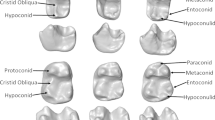Abstract
Intra-arcadal mesiodistal and buccolingual tooth size correlations were evaluated in a sample of 125 caucasoids with ideal occlusion. Dental dimensions were corrected for arcade mength (as a measure of jaw size) by a series of regression analyses of each mesiodistal dimension on the sum of the mesiodistal dimensions within each arcade. Regression coefficients of tooth dimension on arcade length were calculated to gain an insight into the dimensional sensitivity of individual teeth to arcade length variation. The data presented here suggest a strong association between arcadal length (jaw size) dependence, and the dimensional stability of individual teeth. When corrected for arcade length, a definite pattern of tooth size correlation emerges: postcanine maxillary and mandibular teeth are negatively correlated to the anterior teeth and are positively correlated to one another. The hypothesis is developed that anterior and postcanine teeth should be viewed as two separate and negatively size-correlated units, beyond the boundaries of the four morphological tooth classes. Recognition of this basic dichotomous size arrangement within each jaw allows for a reassessment of some of the problems associated with hominid dental evolution.
Similar content being viewed by others
References
Arya B.S., Savara B.S., Thomas D. &Clarkson O., 1974.Relation of sex and occlusion to mesiodistal tooth size. American Journal of Orthodontics, 66: 479–486.
Axelsson G. &Kirveskari P., 1983.Crown size of permanent teeth in Icelanders. Acta Odontologica Scandinavia, 41: 181–186.
Brace C.L., 1967.Environment, tooth form and size in the Pleistocene. Journal of Dental Research, 46: 809–816.
Butler P.M., 1939.Studies of the mammalian dentation — differentition of the postcanine dentition. Proceedings of the Zoological Society, London, 109: 1–36.
Dahlberg A.A., 1945.The changing dentition of man. Journal of the American Dental Association, 32: 676–690.
Finkel D., 1981.An analysys of the Australopithecine dentition. American Journal of Physical Anthropology, 55: 69–80.
Garn S.M., Lewis A.B. &Kerewsky R., 1965.Size interrelationships of the mesial and distal teeth. Journal of Dental Research, 44: 350–354.
Garn S.M., Lewis A.B. &Kerewsky R., 1966.The meaning of bilateral asymmetry in the permanent dentition. Angle Orthodontist, 36: 55–62.
Gingerich P.D. &Ryan A.S., 1979.Dental and cranial variation in living Idriidae. Primates, 20: 141–148
Gingerich P.D. &Schoeninger M.J., 1979.Patterns of tooth size variability in the dentition of Primates. American Journal of Physical Anthropology 51: 457–466.
Gingerich P.D. &Smith B.H., 1985.Allometric scaling in the dentition of Primates and Insectivores. In (W.L. Jungers, Ed.) Size and Scaling in Primate Biology. New York: Plenum Press, pp. 257–264.
Goldstein S., Post D. &Melnick D., 1978.An analysis of cercopithecoids odontometrics, 1: the scaling of the maxillary dentition. American Journal of Physical Anthropology, 49: 517–532.
Groves C.P. &Napier J.R., 1968.Dental dimensions and diet in australopithecines. Proceedings of the Eighth Congress of Anthropology and Ethnological Sciences, 3: 273–276.
Harris E.F. &Nweeia M.T., 1980.Tooth size of Ticuna Indians, Colombia, with phenetic comparisons to other Amerindians. American Journal of Pysical Anthropology, 53: 81–91.
Hylander W., 1975.Incisor size and diet in anthropoids with special reference to Cercopithecidae. Science, 189: 1095–1098.
Kay R.F., 1975.The functional adaptations of primate molar teeth. American Journal of Physical Anthropology, 43: 195–216.
Kieser J.A., 1985.An odontometric analysis of The early Griqua dentition. Anthropologischer Anzeiger, 43: 51–58.
Kieser J.A., 1986.Odontogenic polarity and Butler's field theory. Medical Hypothesis, 20: 103–107.
Kieser J.A., Groeneveld H.T. &Preston C.B., 1985 a.Compensatory tooth size interaction in an preliterate population. Journal of Human Evolution. 14: 739–745.
Kieser J.A., Groeneveld H.T. &Preston C.B., 1985 b.A metric analysis of the South African caucasoid dentition. Journal of the Dental Association of South Africa, 40: 121–125.
Kieser J.A., Groeneveld H.T. &Preston C.B., 1985 c.An odontometric analysis of the Lengua Indian dentition. Human Biology, 37: 611–620.
Kieser J.A., Groeneveld H.T. &Preston C.B., 1986.On the non-existence of compensatory tooth size interactions in a contemporary caucasoid populatio. Journal of Dental Research, 65: 1105–1107.
Kolakowski D. &Bailit H.L., 1981.A differential environmental effect on human anterior tooth size. American Journal of Physical Anthropology. 54: 377–381.
Leakey L.S.B., Tobias P.V. &Napier, J.R., 1964.A new species of the genus Homo from Olduvai Gorge. Nature, 202: 7–9.
Lunt D.A., 1969.An odontometric study of mediaeval Danes. Acta Odontologica Scandinavia, 27 (Supplement 55).
Mizoguchi Y., 1981.Variation units in the human permanent dentition. Bulletin of the National Science museum, Tokyo (D) 7: 29–39.
Mizoguchi Y., 1983.Influences of the earlier developing teeth upon the later developing teeth. Bulletin of the National Science Museum, Tokyo (D) 9: 33–45.
Moorrees C.F.A. &Reed R.b., 1964.Correlation among crown diameters of human teeth. Archives of Oral Biology, 9: 685–697.
Moss M.L., Chase P.S. &Howes R.I., 1967.Comparative odontometry of the permanent postcanine dentition of American Whites and Negroes. American Journal of Physical Anthropology, 27: 125–142.
Osborne R.J., 1967.Some genetic problems in interpreting the evolution of the human dentition. Journal of Dental Research, 46: 945–948.
Pirie P.L., 1978.Allometric scaling in the postcanine dentition with reference to primate diets.Primates, 19: 583–591.
Richardson E.R. &Malhotra S.K., 1975.Mesiodistal crown diameters of the permanent dentition of American Negroes. American Journal of Orthodontics 68: 157–164.
Robinson J.T., 1954.Prehominid dentition and hominid evolution. Evolution, 8: 324–334.
Scilli P.W., 1979.Size and morphology of the permanent dentition of prehistoric Ohio Valley Amerindias. American Journal of Physical Anthropology, 50: 615–628.
Singh M. &Nanda R.S., 1972.Prediction of tooth size and its clinical application. Journal of the Indian Dental Association, 44: 95–98.
Sofaer J.A., 1973.A model relating developmental interaction and differential evolutionary reduction of tooth size. Evolution, 27: 427–434.
Sofaer J.A., Bailit H.L. &MacLean C.J., 1971.A development basis for differential tooth reduction during hominid evolution. Evolution, 25: 509–517.
Sofaer J.A., Chung C.S., Niswander J.D. &Runck D.W., 1971.Developmental interaction, size and agenesis among permanent maxillary incisors. Human Biology, 43: 36–45.
Tobias P.V., 1955.Teeth jaws and genes. Journal of the Dental Association of South Africa, 10: 88–104.
Tobias P.V., 1966.The distinctiveness of Homo Habilis. Nature, 204: 953–957.
Tobias P.V., 1985.Punctuational and phyletic evolution in the hominids. In (E.S. Vrba, Ed.) Species and speciation. Transvaal Museum Monograph, 4: 131–141.
Townsend G.C. &Brown T., 1980.Dental asymmetry in Australian aboriginals. Human Biology, 52: 661–673.
Trinkhaus E., 1983.The Shanidar Neanderthals. New York: Academic Press.
Wallace J., 1978.Evolutionary trends in the early hominid dentition. In (C.J. Jolly, Ed.) Early Hominids in Africa. London: Duckworth, pp. 285–310.
Wolpoff M.H., 1990.Analogies and interpretation in palaeoanthropology. In (C.J. Jolly, Ed.) Early Hominids in Africa. London: Duckworth, pp. 641–704.
Wood B.A., 1981.Tooth size and shape and their relevance to studies of hominid evolution. Philosophical Transactions of the Royal Society of London, B, 292: 65–76.
Author information
Authors and Affiliations
Rights and permissions
About this article
Cite this article
Kieser, J.A., Groeneveld, H.T. Tooth size and arcadal length correlates in man. Int. J. Anthropol. 2, 37–46 (1987). https://doi.org/10.1007/BF02442071
Received:
Accepted:
Issue Date:
DOI: https://doi.org/10.1007/BF02442071




